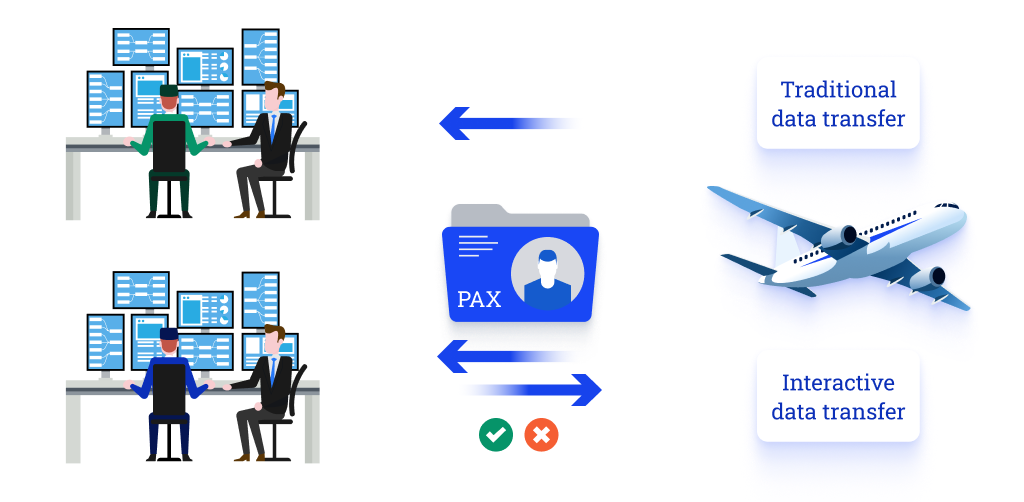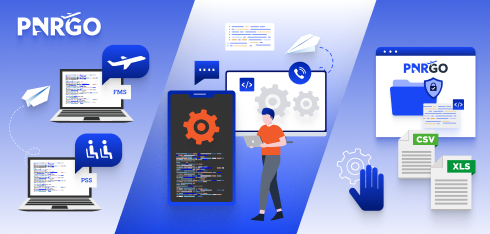Imagine you send your API data according to the local regulations, and then you take your passengers onboard and fly. At the destination airport, one of your passengers is denied entry. Now you are responsible for their detention at the airport and you need to handle their return flight. And here the worst happens - the passenger escapes and causes a major security alert, making you face potential fines and sanctions.
Sounds incredible? Yet this is a real case that happened in 2023 in Manila, Philippines. The country requires operators to submit API data in a traditional, one-way batch transfer. Unsurprisingly, the global trend seems to be shifting towards a slightly different approach, which may look more challenging at first but could significantly lower the risk of similar slip-ups.
Two types of data transfers
Countries around the world differ not only in terms of requirements regarding the data scope or submission times, but they also use different IT systems for collecting passenger data. These systems are built to receive information from air operators in one of the following ways:
- Traditional (Batch) – which involves a one-way communication with the authorities. Here, a proper submission of passenger and crew data ends the process (though some countries may send a confirmation receipt).
- Interactive – which involves a two-way real-time communication with the authorities. The government’s system communicates an instant response to the operator, based on the vetting results of individual passengers. Depending on the response, a further action may be required from the operator (e.g. preventing a certain passenger from boarding your aircraft).
The challenges of TRADITIONAL / BATCH submissions
One-way batch submissions may seem simpler but they still present certain challenges for air operators:
- Time-consuming. It is not just about the time you may need to submit the required data. The data gathering process also plays a role here. You need to collect passport information from all of your passengers before you can send it in one go.
- Risk of human errors. Your submissions need to exactly match the passport data. There is no passport scanning technology involved in batch submissions, and manual entries naturally increase the likelihood of mistakes.
- Penalties and sanctions. Failure to comply with the local regulations may result in financial penalties and additional sanctions.
The challenges of INTERACTIVE submissions
Two-way interactive submissions are slightly more complex. On top of potential penalties and sanctions for non-compliance, you can also face the following challenges:
- Technological challenge. Building an interactive connection is far more advanced as the data needs to flow both ways. Naturally, the development, testing, and certification processes require more skill, time, and effort.
- Codes & procedures to follow. When the local system receives your data, different codes may be sent in response. Your system needs to be able to ‘read’ these responses, and your team needs to know how to act on them (which requires certain procedures to be implemented).
- Round-the-clock support for operations. Since the interactive submissions may require an action on the operator’s side (e.g. preventing a passenger from boarding), you need somebody monitoring the process at all times. All the more with countries that reserve a right to revoke the boarding permission until the last minute.
Global tendency - going interactive
Sadly, it is not up to the operator to choose between ‘traditional (batch)’ and ‘interactive’ submissions, and more and more agencies start to require interactive data exchange. Examples include iAPI, AirExit, and PPP in Canada, TSA Secure Flight in the USA, UPT and ETA in the UK, or EES and ETIAS coming soon in the EU.
Most likely, batch and interactive submissions will co-exist for the time being. Yet ultimately, interactive submissions seem to be the future. They are more effective for border protection, shorten the processing time at the airports, and establish a clearer liability split between the operator and the border agency.
How to stay compliant in the world of interactive passenger data transfers?
For most operators, building interactive connections from scratch is not feasible. Some countries do not even allow direct connectivity. The most convenient solution is using a data service provider who can handle both batch and interactive submissions and who will deliver the passenger status back to you if required.
Are you still feeling lost in the world of batch and interactive data transfers? Would you rather focus on your company's growth instead of poring over changing regulations? Do you wish to implement automated PAX and CREW data compliance for your business?
If you answer ‘yes’ to any of these questions, feel free to contact PnrGo. We can help you create a customized subscription plan that fits your scope of operations.




















